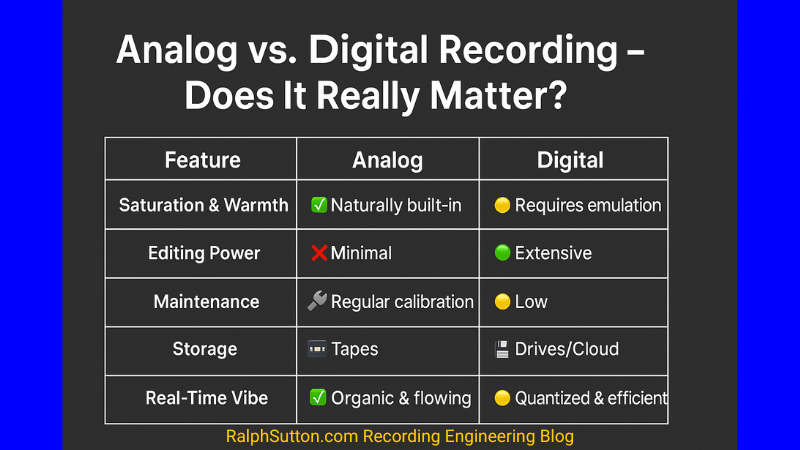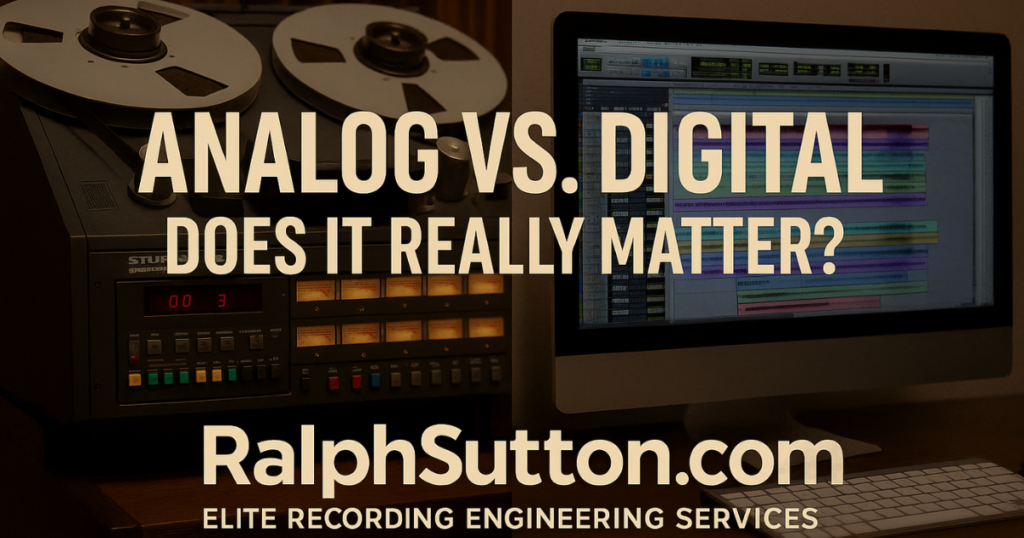🎙️ Analog vs. Digital Recording – Does It Really Matter?
By Ralph Sutton – Elite Recording Engineer | RalphSutton.com
🎬 Introduction – Why This Debate Still Matters
Walk into any studio—whether it’s a Grammy-winning facility or a humble project setup—and eventually this question comes up:

It’s more than just a technical debate—it’s about vibe, sound, and artistic intention.
I’ve worked both sides of the console: from recording on a Studer 24-track tape machine early in my career, to mixing inside Pro Tools Ultimate at some of the top studios in the world. Here’s what I’ve learned—and what truly matters when you’re making records built to last.
🔌 What Is Analog Recording?
Analog recording captures sound as a continuous electrical signal, often tracked to magnetic tape.
Classic tape machines include:
Studer A800 – 2-inch 24-track
Ampex ATR-102 – 1/2-inch 2-track for mixdowns and mastering
Analog recording is physical. It reacts to your signal with saturation, subtle compression, and harmonic richness. It also requires:
Tape calibration and alignment
Reel storage
Hands-on precision
🎧 Sound Characteristics of Analog:
✅ Warm, musical transients
✅ Natural compression from tape saturation
✅ Rich harmonic distortion
🔄 Minor imperfections like hiss, wow, flutter (often welcome)
🖥️ What Is Digital Recording?
Digital recording converts your audio signal into binary data—ones and zeros—via an A/D converter.
Most modern sessions are done in Pro Tools, Logic Pro, or Ableton, either fully in-the-box or using a hybrid setup.
🎧 Sound Characteristics of Digital:
✅ Clean, clinical precision
✅ Infinite editing and automation
✅ No generation loss over time
✅ Scalable setups for any budget

🎤 Ralph’s Real-World Take
I often record to analog first, then transfer to digital for editing and mixing. That gives me the power and feel of tape with the flexibility of modern workflows.
Some of my favorite setups:
Rhythm Sections: Drums, bass, keys, and guitars are tracked to tape, then transferred into Pro Tools. This captures the Funk and unity of musicians playing together in the room.
Vocals: Neumann U 87 → Tube Preamp → Tape → Pro Tools. This adds warmth, presence, and dimensionality to a great vocal take.
Final Mixes: I run mixes through analog summing and print them back to digital—or, when clients request, print to 1/2-inch Ampex 2-track for true analog power and preservation.
🔀 Hybrid Workflow – The Best of Both Worlds
At some of my favorite commercial studios—and in my own project studio—the hybrid approach always wins. I combine the sonic power of analog with the precision of digital.
Track to tape (Studer A800)
Shape with analog gear (1176, LA-2A, Neve, Pultec)
Edit and automate in Pro Tools Ultimate
Master digitally or to Ampex 2-track as needed
When I’m working at home, I rely on world-class tape emulation plugins like:
🎛 UAD Studer A800
🎛 Waves J37
🎛 Slate Digital Virtual Tape Machines
🎯 Final Thoughts – It's Not Either/Or. It’s About Knowing When.
Analog vs. digital isn’t a battle—it’s a strategic choice.
If you’re recording Jazz, Funk, R&B, or Gospel, analog tools can bring depth, weight, and soul that digital systems still chase.
But don’t underestimate digital. The ability to edit, automate, and deliver at speed gives you creative freedom and professional consistency.
“Great engineers use both, knowing when and why to choose each path. That’s where the real power lies.”
🔜 Coming Up Next:
“The Best Direct Boxes for Studio Recording – Capturing Instruments with Clarity and Depth”
You’ll learn how I capture electric bass, synths, and guitars with clean signal paths that retain tone and punch.
Stay tuned—and follow me at RalphSutton.com and on Instagram for behind-the-scenes reels, session tips, and elite-level gear breakdowns.

